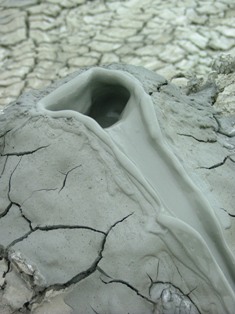The first scientific report into the causes and impact of Lusi, the Indonesian mud volcano located in Eastern Java that erupted on 29th May 2006 in the middle of a rice paddy, has now been published. The study by UK scientists reveals that the mud volcano’s 2006 eruption is likely to continue for months, if not years to come. The team confirms findings in a 2006 United Nations report that the cause of the eruption was most likely the drilling of a borehole during natural gas exploration by Indonesian gas company Lapindo Brantas
The mud volcano could carry on spewing out up to 150,000 cubic metres of mud every day and covering an area of ten square kilometres around the volcanic vent. The landscape is wholly uninhabitable and will remain so for the foreseeable future. 11,000 people have been permanently displaced from their homes. Thirteen people have also died as a result of a rupture in a natural gas pipeline that lay underneath one of the holding dams built to retain the mud.

Prof Richard Davies
Seepage of mud and water are common on Earth but usually a preventable hazard when exploring for oil and gas. However, mud volcano and pressure experts from Aberdeen, Cardiff, and Durham Universities and GeoPressure Technology Ltd analysed satellite images of the area for their study and considered the time-lag between the eruption and an earthquake that occurred two days before discounting the natural geological event as having caused the volcanic activity. They point to that fact that there were no other mud volcanoes in the region following the earthquake and through comparison with other geological examples.
Durham’s Richard Davies of the Centre for Research into Earth Energy Systems (CeREES) says, It is standard industry procedure that this kind of drilling requires the use of steel casing to support the borehole, to protect against the pressure of fluids such as water, oil or gas. In the case of Lusi a pressured limestone rock containing water (a water aquifer) was drilled while the lower part of the borehole was exposed and not protected by casing. As a result rocks fractured and a mix of mud and water worked its way to the surface. Our research brings us to the conclusion that the incident was most probably the result of drilling.

Lusi’s eruption down to human activity
Davies told Spotlight that this is the most likely explanation, This is a model, we have some data but not complete data and this should be treated as a probable model but there is uncertainty. He was unable to comment on either the legal implications of the findings or whether or not the detailed design of the well caused the event. The research team predicts that the locale of the central volcano vent will collapse to form a crater. In addition an area of at least the dimensions of the flow will probably sag over the next few months and years.
Lusi is similar to a ‘blow-out’ (an eruption of water at the surface) that happened offshore of Brunei in 1979, adds Davies, Just as is most probably the case with Lusi, the Brunei event was caused by drilling and it took an international oil company almost thirty years and twenty relief wells and monitoring before the eruption stopped.
Mud volcanoes have until recently remained an enigmatic geological phenomenon. Lusi inadvertently provides science with the first chance to study one from formation onwards. Our work offers a clearer understanding of how they are created and what happens when they erupt, Davies says, We hope that the new insights will prove useful to the oil and gas industry, which frequently encounters pressurised fluid in rock strata that could, if not controlled, force its way to the surface during exploration drilling. Ultimately we hope that what we learn about this incident can help ensure it is less likely to happen again.
At the time of writing, engineers were planning to implement an untested procedure to plug the volcano that involves slowly dropping chains of concrete balls into its opening. Up to fifty ball and chains will be dropped in each day in a scheme devised by geophysicists Bagus Nurhandoko, Satria Bijaksana, and Umar Fauzi of the Bandung Institute of Technology.
Scientists sceptical of blocking the exit route for the mud in this way, say that the mud will get out elsewhere. Davies’ colleague Richard Swarbrick, managing director of GeoPressure says that the approach may work but is quoted in the journal Nature as saying, I would predict that the mud would probably exit at the other holes, or farther along.
Further reading
GSA Today, 2007, 17, 4-9
http://dx.doi.org/10.1130/GSAT01702A.1
Professor Richard Davies
http://www.dur.ac.uk/earth.sciences/staff/?id=3355
Nature, 2007, 445, 470
http://dx.doi.org/10.1038/445470a